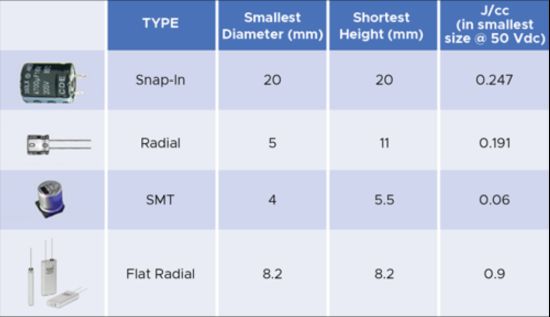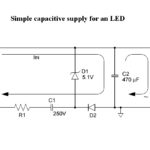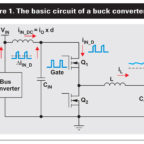The traditional cylindrical packages that have characterized electrolytic caps are giving way to flat packs optimized for small spaces.
Mario Dipietro, Flatpack Div., Cornell Dubilier Electronics, Inc.
The first reported developments of electrolytic “condensers” were in the 1880s, with significant advances in the mid 1920s. In 1948, etched-foil technology developed by Illinois Condenser (today’s Illinois Capacitor) and Alcoa allowed higher capacitance values in much smaller case sizes.
Over the years, there have been incremental improvements, including new higher-gain anode etched-foil designs, higher-performance electrolytes, better construction technology and in-line QC testing. These updates have been responsible for size reductions, higher CV (capacitance – voltage) ratings for equivalent package sizes, lower ESR (equivalent series resistance), less power loss for the same amount of ripple current, and higher temperature ratings. The introduction of supercapacitors created a whole new product design paradigm. Supercaps are a form of electrolytic which offer massive storage capabilities at relatively low voltage ratings. In some applications, supercapacitors have even replaced batteries and have the advantages of quick charging and no loss of performance with each charge.
Cylindrical form factors have long prevailed, even at the surface-mount size level. Cylindrical package designs are easy to manufacture and versatile. However, it’s tough to significantly reduce the size of electrolytics. The reason becomes evident from a dissection of a typical electrolytic. It turns out that packaging materials (such as case, spacers, gaskets, etc.) take up about 60% of the space.

There are also different designs for cylindrical aluminum electrolytics, as can be seen by comparing standard radial-leaded capacitors to radial snap-in types. The snap-ins, or snap mounts, provide a stronger mechanical connection to the PC board, and more robust internal construction, but they require vertical mounting. Thus they are unsuited to low-profile applications. Despite these differences, packaging elements take up a significant amount of the volume in both designs.
When cylindrical-style aluminum electrolytic capacitors are reduced in size, it becomes especially difficult to realize high energy densities because packaging occupies a higher percentage of the volume. Until now, applications requiring profile heights of under 10 mm necessitated creating banks of small capacitors. This approach takes up a lot of PCB area for both the component footprints and space in between.
The latest electrolytic game-changer came when Cornell Dubilier began offering flat electrolytic capacitors in the 1990s. At first, these devices were high-value components, designed exclusively for Mil/Aero and other high-reliability applications.

The newest generation of flat aluminum electrolytic capacitors have retained many of those attributes but with better economics. They are also lightweight and highly cost-competitive with more established high-performance technologies.
Aluminum electrolytic capacitors can provide high capacity, low impedance and high-voltage ratings. Consequently, they offer benefits that are difficult to match with other capacitor dielectric materials. Flat electrolytics retain those qualities but can be designed for lower profiles, higher energy density and longer life.

The idea of a high CV flat aluminum electrolytic fits well with board-level component trends. Flatpack technology manages to lower the component height by flattening the windings. Greater space efficiency is possible by placing those windings inside of a laser-welded, aluminum case. The differences in construction raise the cost of an individual Flatpack component, but the total cost of the bulk-storage capacitance is lower. This is because the high-energy density of the Flatpack makes it possible for one device to replace banks of cylindrical aluminum electrolytics.
The Mil/aero versions of the Flatpack are designed to handle high vibration, up to 80 g, and some have true hermetic, glass-to-metal seals that prevent dry-out. These features, along with their high capacitance retention at -55°C, make them good candidates for military and aerospace applications. In particular, they are excellent options for replacing banks of costly wet tantalum capacitors.
Advantages of flat electrolytic capacitors
Flat aluminum electrolytics are unlikely to ever fully replace their cylindrical counterparts. But flat electrolytics are good alternatives to banks of smaller capacitors when there is a need for low profiles, light weight, and high performance.
Owing to its high-energy density and low profile, a single Flatpack can replace arrays of SMT, radial or axial aluminum electrolytic capacitors. This reduction in part count also improves system reliability. Of course, each capacitor eliminated also eliminates two PCB connection points that can be potential sources of failure.

There are now two new less expensive executions of Flatpack technology. The 85°C THA Series Thinpack capacitors are only 8.2-mm high, and the 105°C-rated THAS version has a profile of 9 mm. This height is comparable to that of V-chip electrolytics and board-mounted axials, yet the device offers much higher bulk-storage capability.
Both kinds of devices include a special valve to vent hydrogen gas, thereby reducing potential swelling that could arise if the internal pressure is not relieved. To work at 105°C, the THAS Series includes a 0.38-mm stainless steel sleeve which prevents the package from expanding at elevated temperatures.
Potential applications include any circuits that require flat, high-capacitance bulk storage and filtering. This includes tablets, laptops, instrumentation, commercial-grade LED driver modules, compact power supplies, drones and RPVs, set-top boxes, 1U rack-mounted devices, and others. Key performance specifications include up to a 3,000-hour life at 105°C without derating (THAS), and an energy density of up to 0.9 J/cc.
The need for low-profile, small devices will push manufacturers toward devising thinner and thinner capacitors, with even higher energy density. Some supercapacitors now sit in thin packages, so it’s reasonable to expect to see some electrolytics in equally thin profiles. Applications likely to benefit from flat-capacitors include power applications requiring high capacitance, bulk storage, and filtering of a dc supply.
In power circuitry, smaller often means hotter, so performance at higher temperatures is also becoming more important. Flat electrolytic capacitors can bring more flexibility in the design of end products. And as this technology rapidly expands, economics and performance will continue to improve.
Several manufacturers are currently developing technology that will squeeze package size even further. Thin supercapacitors are an indication of the trend. Some are in battery-style flat packages that are just a few millimeters thick. Advances in manufacturing technology will allow similar packaging for aluminum electrolytics. Besides being much smaller and lighter, capacitors will be made to fit available off-board spaces. All these component advances are opportunities for engineers to rethink what is possible and to find ways of making generational changes in their company’s end products.





Leave a Reply